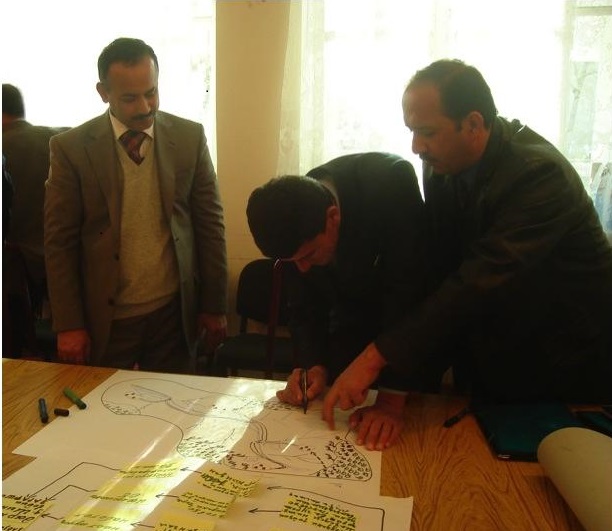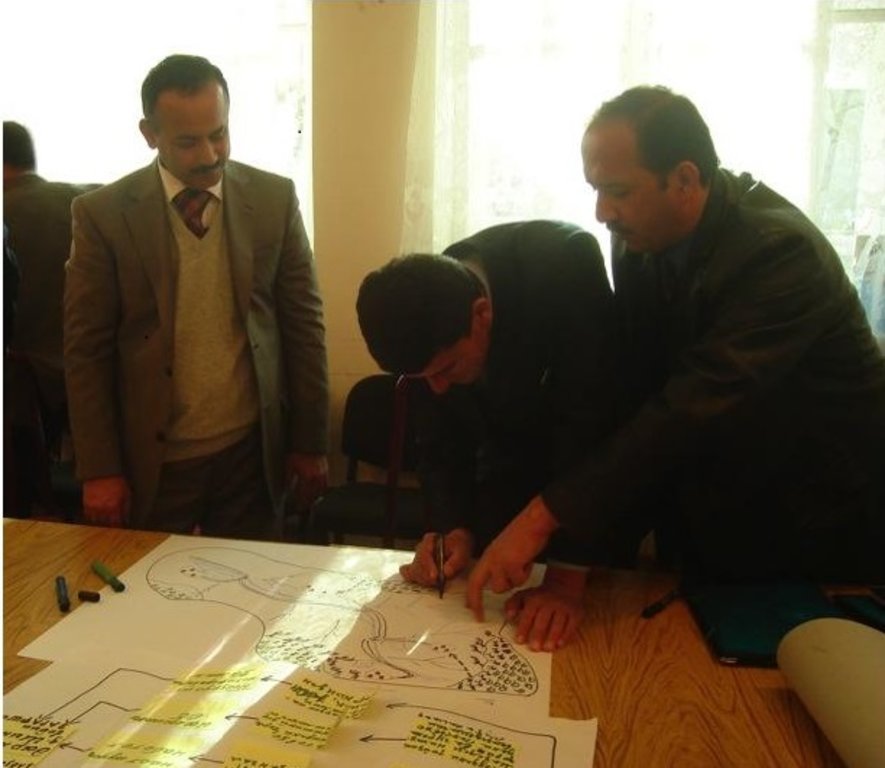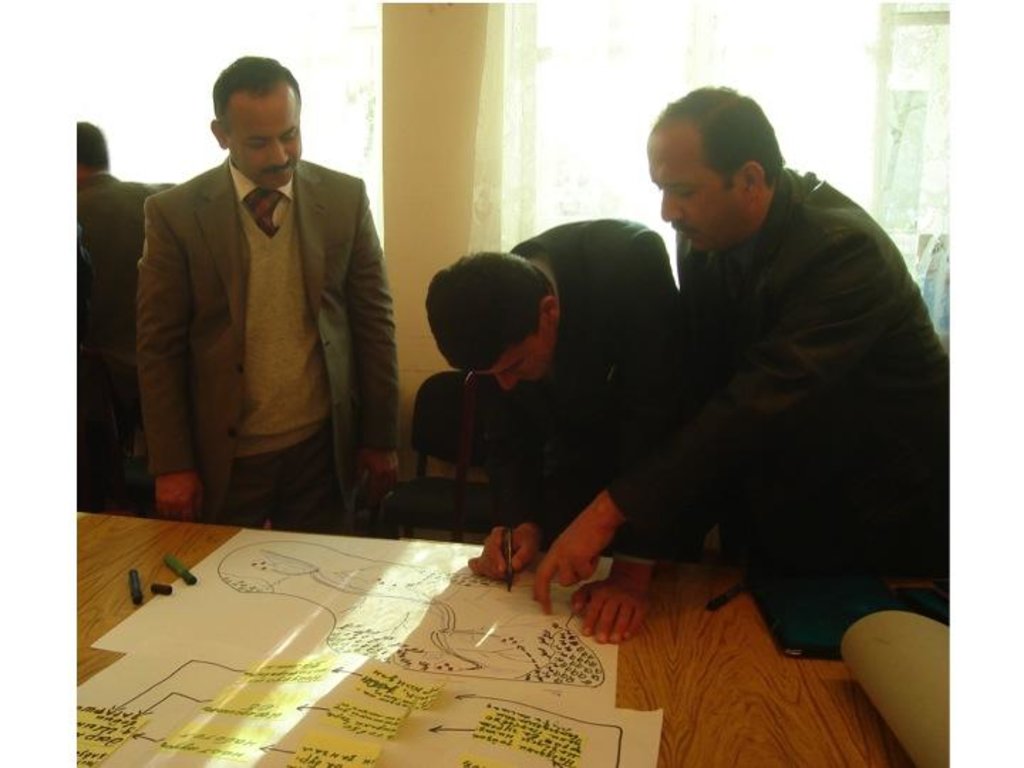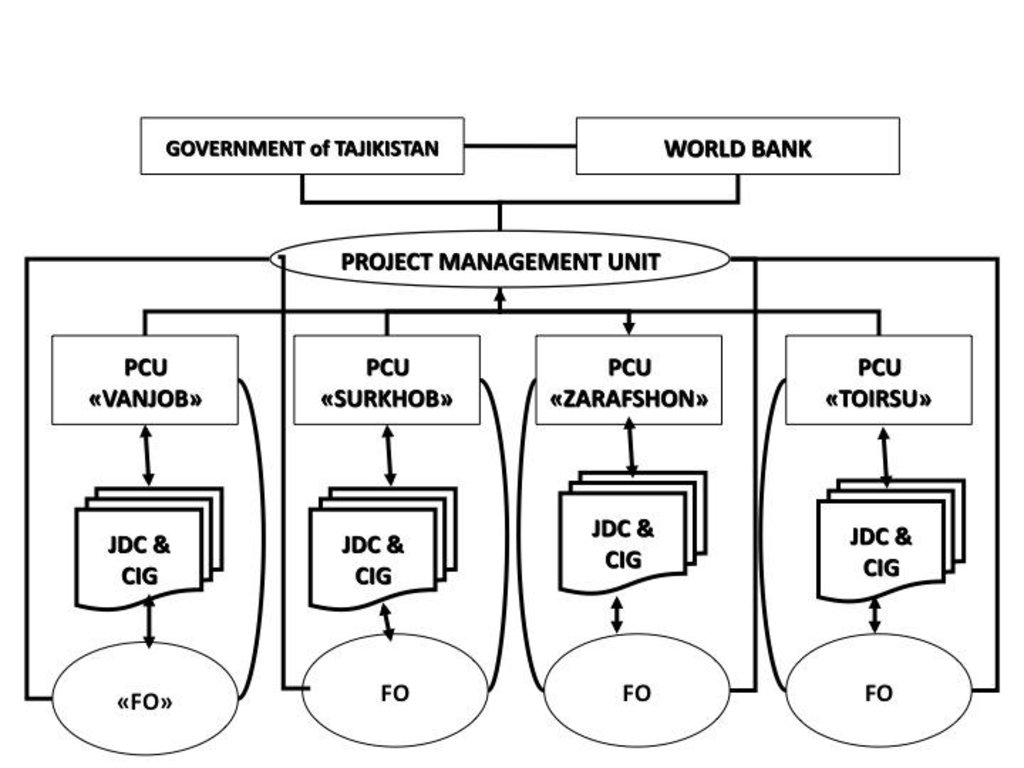Eligibility Criteria and Environmental Planning Tools for SLM [ทาจิกิสถาน]
- ผู้สร้างสรรค์:
- การอัพเดท:
- ผู้รวบรวม: Nandita Jain
- ผู้เรียบเรียง: –
- ผู้ตรวจสอบ: David Streiff, Alexandra Gavilano, Joana Eichenberger
approaches_2578 - ทาจิกิสถาน
- บทสรุปทั้งหมดในรูปแบบของ PDF
- บทสรุปทั้งหมดในรูปแบบของ PDF เพื่อพิมพ์
- บทสรุปทั้งหมดในรูปหน้าเว็บ
- บทสรุปทั้งหมด (ไม่มีการจัดเรียง)
- Eligibility Criteria and Environmental Planning Tools for SLM: 2 พฤศจิกายน 2021 (public)
- Eligibility Criteria and Environmental Planning Tools for SLM: 10 สิงหาคม 2017 (inactive)
- Eligibility Criteria and Environmental Planning Tools for SLM: 7 กรกฎาคม 2017 (inactive)
- Eligibility Criteria and Environmental Planning Tools for SLM: 7 กรกฎาคม 2017 (inactive)
ดูส่วนย่อย
ขยายทั้งหมด ย่อทั้งหมด1. ข้อมูลทั่วไป
1.2 รายละเอียดที่ติดต่อได้ของผู้รวบรวมและองค์กรที่เกี่ยวข้องในการประเมินและการจัดเตรียมทำเอกสารของแนวทาง
ผู้เชี่ยวชาญ SLM:
Mott Jessica
World Bank
สหรัฐอเมริกา
ชื่อของโครงการซึ่งอำนวยความสะดวกในการทำเอกสารหรือการประเมินแนวทาง (ถ้าเกี่ยวข้อง)
Pilot Program for Climate Resilience, Tajikistan (WB / PPCR)ชื่อของโครงการซึ่งอำนวยความสะดวกในการทำเอกสารหรือการประเมินแนวทาง (ถ้าเกี่ยวข้อง)
World Bank (World Bank) - สหรัฐอเมริกา1.3 เงื่อนไขที่เกี่ยวข้องกับการใช้ข้อมูลที่ได้บันทึกไว้ผ่านทาง WOCAT
วันที่เก็บรวบรวมข้อมูล (ภาคสนาม):
19/11/2007
ผู้รวบรวมและวิทยากรหลักยอมรับเงื่อนไขเกี่ยวกับการใช้ข้อมูลที่ถูกบันทึกผ่านทาง WOCAT:
ใช่
1.4 การอ้างอิงถึงแบบสอบถามเรื่องเทคโนโลยี SLM
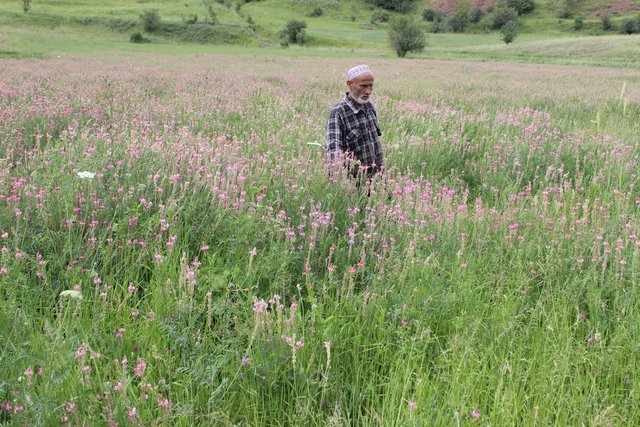
[ทาจิกิสถาน]
None
- ผู้รวบรวม: MIZROBSHO AMIRBEKOV
2. คำอธิบายของแนวทาง SLM
2.1 การอธิบายแบบสั้น ๆ ของแนวทาง
Using eligibility criteria and participatory environmental analyses for selecting and assessing SLM investments.
2.2 การอธิบายอย่างละเอียดของแนวทาง
การอธิบายอย่างละเอียดของแนวทาง:
Aims / objectives: As part of the Community Agriculture and Watershed Management Project (CAWMP), tools were developed to ensure farmers chose appropriate SLM technologies while preparing Community Action Plans (CAPs) and to improve environmental assessments during CAP preparation and in rural investment activities.
Methods: Eligibility Criteria: CAWMP financed small grants for three types of rural production investments: farm productivity, rural infrastructure, and land resource management (the largest type). The eligibility criteria for these grants included meeting at least one of the following impacts on fragile lands: • Prevent/reduce soil erosion • Increase vegetative cover through perennial crops and pasture • Provide soil and moisture conservation • Improve soil quality • Improve water use efficiency • Increase sustainable fodder/wood supply • Increase sustainable renewable energy supply • Increase integrated pest management These criteria ensured an environmental focus, and kept the grant proposals consistent with a list of eligible activities which is critical for a large-scale, community-driven project such as CAWMP. The criteria helped avoid diversion of grant funds to investments not directly related to land sustainability. Combining income-generating investments with environmental criteria encouraged sustainable land use by addressing vital interests of local people. The criteria were used to monitor local environmental impacts. Project arrangements provided for land use right certificates to beneficiaries with Project-financed investments on sloping lands, giving them a stake in the sustained productivity of their land. Traditionally such land use right certificates were issued only for irrigated and other valley areas. The Project financed a total of almost US$ 5.3 million in grants for land resource management, through almost 2,300 subprojects, benefitting over 43,000 households.
Stages of implementation: Participatory environmental analyses. A review of investment proposals and field activities in 2007 revealed that farmers were not capable of properly assessing their local land management problems, identifying the most environmentally appropriate investments or actions, nor monitoring their effectiveness. Tools were developed for project partners and officials to address these concerns including: 1) Developing Conceptual Models of Local Environments/Watersheds; 2) Mapping Local Environments/Watersheds and Associated Threats; 3) Identifying and Ranking Environmental Threats; and 4) Community Environmental Assessment. More than 50 persons attended the two-day interactive training course on the use of the tools. Detailed guidelines for facilitators and trainers to use the tools were prepared in Tajik and Russian. While the training could not influence many of the SLM-related investments already submitted for funding, participants urged that similar training be conducted at the inception of SLM-related projects and that the tools be requirements of SLM planning.
2.3 รูปภาพของแนวทาง
2.5 ประเทศ ภูมิภาค หรือสถานที่ตั้งที่ได้นำแนวทางไปใช้
ประเทศ:
ทาจิกิสถาน
ภูมิภาค/รัฐ/จังหวัด: :
Sughd, RRS, Khatlon, GBAO
ข้อมูลเฉพาะเพิ่มเติมของสถานที่ตั้ง:
Jirgital, Tajikibad, Vanj, Aini, Matcha, Penjikent, Danghara
ความคิดเห็น:
The Community Agriculture and Watershed Management Project was implemented in four project sites/watersheds - Surkhob, Toirsu, Vanjob and Zarafshan - and included 7 districts/raions and 39 sub-districts/jamoats. The total catchment area was 35,000km2. Total arable, farm and pasture land was approximately 319,500ha
Map
×2.6 วันที่เริ่มต้นและสิ้นสุดของแนวทาง
ระบุปีที่เริ่ม:
2005
การสิ้นสุดลง (ถ้าแนวทางไม่ได้ใช้อีกต่อไป):
2012
2.7 ประเภทของแนวทาง
- ใช้โครงงานหรือแผนงานเป็นฐาน
2.8 เป้าหมายหรือวัตถุประสงค์หลักของแนวทาง
The Approach focused mainly on other activities than SLM (participatory environmental analyses, eligibility criteria, monitoring, assessment, training, guidelines, )
Application of the criteria and tools to help ensure that proposed rural investments in Community Action Plans kept their environmental management focus.
The SLM Approach addressed the following problems: Inappropriate investments with questionable SLM benefits proposed in CAPs. Uneven, sometimes, missing focus on environmental risks and benefits in small grant proposals for rural production investments. Lack of skills in and knowledge of participatory environmental appraisals.
2.9 เงื่อนไขที่เอื้ออำนวยหรือเป็นอุปสรรคต่อการนำเทคโนโลยีภายใต้แนวทางนี้ไปปฏิบัติใช้
การจัดตั้งระดับองค์กร
- เป็นอุปสรรค
Legacy of command-economy focus on infrastructure investments for improving land management and agriculture
Treatment through the SLM Approach: Tools to analyse a range of environmental aspects of land management and propose alternative technologies and approaches, training for project implementers and stakeholders.
ความรู้เกี่ยวกับ SLM การเข้าถึงการสนับสนุนด้านเทคนิค
- เป็นอุปสรรค
Lack of appropriate analyses of environmental relationships, threats, risks and impacts in choice and design of investment proposals at the village level
Treatment through the SLM Approach: Establishing eligibility criteria, development of participatory learning tools on environmental issues, training for project partners and stakeholders.
3. การมีส่วนร่วมและบทบาทของผู้มีส่วนได้ส่วนเสียที่เกี่ยวข้อง
3.1 ผู้มีส่วนได้ส่วนเสียที่เกี่ยวข้องในแนวทางนี้และบทบาท
- ผู้ใช้ที่ดินระดับท้องถิ่นหรือชุมชนระดับท้องถิ่น
Jamoat (Sub-district) Development Committees
- ผู้เชี่ยวชาญ SLM หรือที่ปรึกษาการเกษตร
Facilitating organization staff, local government specialists, project field staff
- รัฐบาลแห่งชาติ (ผู้วางแผน ผู้ทำการตัดสินใจ)
Project Management Unit (PMU), Project Coordination Units (PCUs)
ถ้ามีผู้มีส่วนได้ส่วนเสียหลายคนที่เกี่ยวข้องให้ระบุหน่วยงานตัวแทน:
PMU
3.2 การเกี่ยวข้องของผู้ใช้ที่ดินระดับท้องถิ่นหรือชุมชนระดับท้องถิ่นในช่วงต่างๆของแนวทาง
| ความเกี่ยวข้องของผู้ใช้ที่ดินระดับท้องถิ่นหรือชุมชนระดับท้องถิ่น | ระบุผู้ที่มีส่วนเกี่ยวข้องและอธิบายกิจกรรม | |
|---|---|---|
| การริเริ่มหรือการจูงใจ | ไม่มี | |
| การวางแผน | ไม่มี | |
| การดำเนินการ | ปฏิสัมพันธ์ | Villagers used criteria for selecting and designing rural investments. JDCs received training in environmental tools |
| การติดตามตรวจสอบหรือการประเมินผล | ปฏิสัมพันธ์ | Local JDCs assisted in assessment of rural production investments using eligibility criteria as well as other factors. |
| Research | ไม่มี |
3.3 แผนผังแสดงขั้นตอนการทำงาน (ถ้ามี)
คำอธิบาย:
CAWMP - Implementation Arrangements and Project Partners
ผู้เขียน:
Project Management Unit (Dushanbe)
3.4 การตัดสินใจเลือกใช้เทคโนโลยี SLM
ระบุผู้ที่ทำการตัดสินใจเลือกเทคโนโลยีมากกว่าหนึ่งวิธีไปปฏิบัติใช้:
- ผู้ใช้ที่ดินเป็นผู้ตัดสินใจหลัก โดยการสนับสนุนจากผู้เชี่ยวชาญ SLM
การอธิบาย:
Common Interest Group members and technical specialists from the respective facilitating organisation and project coordination unit made decisions on the choice of SLM technologies in rural investments proposed in Community Action Plans. A number of SLM technologies could be used in any one proposal.
Decisions on the method of implementing the SLM Technology were made by mainly by land users supported by SLM specialists. Common Interest Group members and technical specialists from the respective facilitating organisation and project coordination unit made decisions on the method/s for implementing SLM technologies in any one proposal.
4. การสนับสนุนด้านเทคนิค การสร้างขีดความสามารถ และการจัดการด้านความรู้
4.1 การสร้างขีดความสามารถ / การอบรม
ได้มีการจัดอบรมให้แก่ผู้ใช้ที่ดินหรือผู้มีส่วนได้ส่วนเสียคนอื่น ๆ หรือไม่:
ใช่
ให้ระบุว่าใครเป็นผู้ได้รับการอบรม:
- เจ้าหน้าที่ภาคสนาม / ที่ปรึกษา
- Jamoat (sub-district) Development Committees
หัวข้อที่พูด:
Participatory environmental analyses, assessing rural investments including use of eligibility criteria.
4.2 การบริการให้คำแนะนำ
ผู้ใช้ที่ดินมีการเข้าถึงการรับบริการให้คำปรึกษาหรือไม่:
ไม่ใช่
4.3 การเสริมความแข็งแกร่งให้กับสถาบัน (การพัฒนาองค์กร)
สถาบันได้รับการจัดตั้งขึ้นมาหรือเสริมความแข็งแกร่งโดยแนวทางนี้หรือไม่:
- ใช่ ปานกลาง
ระบุระดับของสถาบันที่ได้รับการเสริมความแข็งแกร่งหรือจัดตั้งขึ้นมา:
- ท้องถิ่น
ให้รายละเอียดเพิ่มเติม :
See TAJ047 on the role and activities of Jamoat (sub-district) Development Committees
4.4 การติดตามตรวจสอบและประเมินผล
การติดตามตรวจสอบและประเมินผลเป็นส่วนหนึ่งของแนวทางหรือไม่:
ใช่
ความคิดเห็น:
Use of tools aspects were ad hoc monitored by project staff through observations; indicators: Types of investments proposed, Quality of proposals,
Application of criteria aspects were regular monitored by project staff through observations; indicators: Types of proposals, use in assessment of rural investments
There were no changes in the Approach as a result of monitoring and evaluation: Not directly relevant
There were no changes in the Technology as a result of monitoring and evaluation: No directly relevant
4.5 การวิจัย
การวิจัยเป็นส่วนหนึ่งของแนวทางหรือไม่:
ไม่ใช่
5. การสนับสนุนด้านการเงินและวัสดุอุปกรณ์
5.1 ระบุงบประมาณประจำปีสำหรับแนวทาง SLM นี้
ถ้าหากว่างบประมาณประจำปีไม่เป็นที่ทราบแน่นอน ให้ระบุช่วงลงไป:
- 10,000-100,000
แสดงความคิดเห็น (แหล่งของการระดมทุน ผู้บริจาคคนสำคัญ):
Approach costs were met by the following donors: international (World Bank and Global Environment Facility): 95.0%; government (Estimate of co-financing ): 5.0%
5.4 เครดิต
มีการจัดหาเครดิตมาให้ภายใต้แนวทาง SLM หรือไม่:
ไม่ใช่
6. การวิเคราะห์ผลกระทบและการสรุป
6.1 ผลกระทบของแนวทาง
ช่วยให้ผู้ใช้ที่ดินนำเอาเทคโนโลยี SLMไปใช้และบำรุงรักษาสภาพไว้ได้หรือไม่:
- ไม่ใช่
- ใช่ เล็กน้อย
- ใช่ ปานกลาง
- ใช่ อย่างมาก
More appropriate investments chosen, criteria contributed to environmental monitoring of rural investments.
Not directly relevant
Did other land users / projects adopt the Approach?
- ไม่ใช่
- ใช่ เล็กน้อย
- ใช่ ปานกลาง
- ใช่ อย่างมาก
Interest shown by organisations and projects in participatory tools.
6.2 แรงจูงใจหลักของผู้ใช้ที่ดินเพื่อที่จะนำ SLM ไปปฏิบัติใช้
- การผลิตที่เพิ่มขึ้น
- การเข้าร่วมสมทบในขบวนการ โครงการ กลุ่ม เครือข่าย
- จิตสำนึกด้านสิ่งแวดล้อม
- well-being and livelihoods improvement
6.3 ความยั่งยืนของกิจกรรมของแนวทาง
ผู้ใช้ที่ดินสามารถทำให้สิ่งต่างๆ ที่ได้ปฏิบัติใช้โดยแนวทางนี้ยั่งยืนได้หรือไม่ (โดยไม่มีการสนับสนุนจากภายนอก):
- ใช่
ถ้าตอบว่าใช่ ให้อธิบายว่าอย่างไร :
Land-users may require facilitation assistance to conduct environmental analyses, but some individuals and groups may be able to do so independently. Some JDC members may be able to assist. Eligibility criteria along with list of activities can used in other projects or independently by beneficiaries.
6.4 จุดแข็งและข้อได้เปรียบของแนวทาง
| จุดแข็ง / ข้อได้เปรียบของแนวทางในทัศนคติของผู้ใช้ที่ดิน |
|---|
| JDCs learned more about environmental relationships, impacts beyond immediate areas, as well as biodiversity aspects of SLM. Also resulted in shifts in thinking about causes of degradation and effects, and so the choice of appropriate activities (How to sustain/ enhance this strength: Ensure that training in the tools, monitoring and related activities are given at the start of projects and programmes.) |
| จุดแข็ง / ข้อได้เปรียบของแนวทางในทัศนคติของผู้รวบรวมหรือวิทยากรหลัก |
|---|
| Criteria were understandable and integrated into monitoring of project rural investments. (How to sustain/ enhance this strength: Disseminate formats for investment monitoring. Criteria can be also be integrated into appraisal stages for rural investments. ) |
| Tools highlighted environmental issues neglected during initial participatory rural appraisals. (How to sustain/ enhance this strength: Continue dissemination of tools, and further refine some tools as needed.) |
6.5 จุดอ่อน / ข้อเสียเปรียบของแนวทางและวิธีในการแก้ไข
| จุดอ่อน / ข้อเสียเปรียบในทัศนคติของผู้รวบรวมหรือวิทยากรหลัก | สามารถแก้ไขปัญหาได้อย่างไร |
|---|---|
| Limited impact of tools training due to project implementation schedule. | Provide training in initial stages of projects. |
7. การอ้างอิงและการเชื่อมต่อ
7.2 การอ้างอิงถึงสิ่งตีพิมพ์
ชื่อเรื่อง ผู้เขียน ปี ISBN:
Environmental Assessment Templates for Rural Production Investments in CAWMP (2009, English, Russian and Tajik)Tools for Participatory Environmental Analyses (2007, Separate Guidelines for Trainers and Facilitators, English, Russian and Tajik)Eligible and Ineligible Activities for Rural Production Investments in CAWMP (2007, English and Russian)Outline and Assessment for Training in Tools for Participatory Environmental Analyses (2007, English)
ช่องทางในการสืบค้น และราคา:
Project Management Unit
ชื่อเรื่อง ผู้เขียน ปี ISBN:
Tools for Participatory Environmental Analyses (2007, Separate Guidelines for Trainers and Facilitators, English, Russian and Tajik)
ช่องทางในการสืบค้น และราคา:
Project Management Unit
ชื่อเรื่อง ผู้เขียน ปี ISBN:
Eligible and Ineligible Activities for Rural Production Investments in CAWMP (2007, English and Russian)
ช่องทางในการสืบค้น และราคา:
Project Management Unit
ชื่อเรื่อง ผู้เขียน ปี ISBN:
Outline and Assessment for Training in Tools for Participatory Environmental Analyses (2007, English)
ช่องทางในการสืบค้น และราคา:
Project Management Unit
ลิงก์และโมดูล
ขยายทั้งหมด ย่อทั้งหมดลิงก์

[ทาจิกิสถาน]
None
- ผู้รวบรวม: MIZROBSHO AMIRBEKOV
โมดูล
ไม่มีโมดูล


